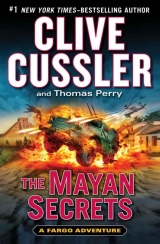
Текст книги "The Mayan Secrets"
Автор книги: Clive Cussler
Жанр:
Морские приключения
сообщить о нарушении
Текущая страница: 1 (всего у книги 20 страниц)
Clive Cussler, Jim DeFelice
The Mayan Secrets
Chapter 1
RABINAL, GUATEMALA, 1537
Beyond midnight, Friar Bartolomé de Las Casas was still in his candlelit study in the Mayan mission at Rabinal. Before he went to bed, he had to write his daily installment of his report to Bishop Marroquin. Persuading the Church hierarchy of the success of the Dominican missions in Guatemala was going to be possible only if it was properly documented. He took off his black cloak and hung it on a peg by the door. He stood for a moment, listening to the night sounds – the gentle coo of birds, the insects chirping in the stillness.
He went to the wooden cabinet on the wall, opened it, and took out the precious book. Kukulcan, a man of royal lineage who was famous for his great learning, had brought this book and two others to Friar Bartolomé so he could examine them. Las Casas set the book on the table. He had been studying the book for months, and tonight’s work was going to be important. He placed a sheet of parchment on the table and then opened the marvelous book.
This page was divided into zones. There were pictures of six fantastic humanlike creatures he assumed were deities, all seated and looking to the left, and six vertical columns of complicated written symbols beneath them, which Kukulcan had told him was Mayan writing. The pages were a clean white, and the pictures were done in red, green, and yellow, with an occasional blue. The writing was black. Friar Las Casas trimmed his pen to make it as fine as he could, divided his sheet into six vertical columns, and began to copy the symbols. It was hard, demanding labor, but he saw it as a part of his work. It was as much a part of his Dominican calling as his clothing – the white habit that signified purity and the black cloak over it that signified penance. He had no idea what the symbols meant or the names of the mythical deities, but he knew that the images contained deep knowledge that the Church would need to understand its new converts.
For Las Casas, managing the gentle, patient conversion of the Mayan Indians was a personal duty, a penance. Bartolomé de Las Casas had not come to the New World in peace. He had come with a sword. In 1502, he had sailed from Spain for Hispaniola with the governor, Nicolás de Ovando, and accepted an encomienda, a conquered land, and the right to enslave all the Indians he found on it. Even in 1513, after a decade of cruelty by the conquerors, and having been ordained as a priest, he joined in the conquest of the Indians of Cuba, while accepting another royal grant of land and Indians as his share of the plunder. As he thought about his early life now, he was sick with shame and regret.
When he’d finally admitted to himself that he had participated in a great sin, he’d begun his personal program of repentance and reformation. Las Casas would always remember the day in 1514 when he had stood up and denounced his past actions and returned his Indian slaves to the governor. Remembering that day was like touching the scar of an old burn. After that, he had sailed back to Spain to plead with the powerful for the protection of the Indians. That had been twenty-three years ago, and since then he had worked tirelessly, devoting his writings and his labor to making up for the wrongs he had done and countenanced.
He worked for several hours at his copying until he had finished the page. He placed his parchment copy in the bottom of a box of sermons with all of the other pages he had copied. As he moved about the small room, the candle flame flickered. He placed another clean sheet on the table, waited for the candle to be still and throw a steady yellow light again, and then started the next task. He dipped his pen in the ink pot and began with the date: 23 January 1537. Then his pen stopped, held above the paper.
He heard sounds that were familiar to him and made him instantly angry. He heard the feet of soldiers marching in a platoon, their boots hitting the damp earth, spurs jangling and sword hilts clanking as they swung against steel at the bottom of each soldier’s cuirass.
“No,” he muttered. “Not again, Lord. Not here.” It was a violation, a betrayal. Governor Maldonado had broken his promise. If the Dominican friars succeeded in pacifying and converting the natives, there were to be no colonists arriving to claim encomiendas—and, above all, no soldiers. The soldiers who had not been able to conquer the Indians in these regions by fighting must not come in now and enslave them after the friars had befriended them.
Las Casas threw on his black robe, flung open his door, and ran down the long gallery, his leather sandals flapping on the brick pavement. He could see the troop of Spanish cavalry soldiers, all armed for battle with swords and lances, their Toledo-steel cuirasses and cabassets gleaming in the light of the bonfire they were building in the square across from the church.
Las Casas ran to them, waving his arms and shouting, “What are you doing? How dare you light a fire in the middle of the mission square. The roofs of these buildings are nothing but straw!”
The soldiers saw and heard him, and two or three of them bowed to him politely, but these were professional fighters, conquistadors, and they knew arguing with the head of a Dominican mission was not going to make them richer or more powerful.
When he charged at them, they stepped aside or retreated a step but would not engage with him.
“Where is your commander?” he said. “I am Father Bartolomé de Las Casas.” He seldom used his priestly title, but he was, after all, a priest, the first ever to be ordained in the New World. “I demand to see your commander.”
The nearest pair turned in the direction of a tall, dark-bearded man. Las Casas noticed that this man’s armor was a bit more ornate than what the other men wore. His had filigree engraved on its surfaces, with gold inlay. As Las Casas approached, the man called, “Fall in,” and his men lined up in four rows, facing him. Las Casas stepped between him and his soldiers.
“What are soldiers doing bursting into a Dominican mission in the middle of the night? What business do you have here?”
The man looked at him wearily. “We have a job to do, Friar. Take up your complaints with the governor.”
“He promised me that soldiers would never come here.”
“Perhaps that was before he learned of the devil’s books.”
“The devil doesn’t have anything to do with books, you idiot. You have no right to be here.”
“Nonetheless, we are here. Pagan books have been seen here and reported to Fra Toribio de Benevente, who asked the governor for help.”
“Benevente? He has no authority over us. He’s not even a Dominican. He’s a Franciscan.”
“Those internal squabbles are your business. Mine is to find and destroy the evil books.”
“They’re not evil. They contain the knowledge of these people and all the information that exists about them, their ancestors, their neighbors, their philosophy, language, and cosmology. They’ve lived here for thousands of years, and their books are a gift to the future. They tell us things we could never find out in any other way.”
“You’re misinformed, Friar. I’ve seen some of them myself. There are nothing but pictures and signs of the demons and fiends they worship.”
“These people are being converted, one at a time and voluntarily. Not the way the Franciscans do it, baptizing ten thousand people at a time. The old Mayan gods have been diminished to mere symbols. We’ve made great progress here in a short time. Don’t waste all the work we’ve done by proving to them that we’re savages.”
“Us? Savages?”
“Savages. You know – people who destroy art, burn books, kill people they don’t understand, and make slaves of their children.”
The commander turned to his men. “Get him away from me.”
Three soldiers took hold of Las Casas and, as gently as possible, pulled him away from the square. One of them said, “Please, Father, I’m begging you. Stay away from the commander. He has orders and he’d rather die than disobey.” They backed away from him, turned, and ran back to the square.
Las Casas took a last look at the soldiers building their big bonfire. The soldiers running back and forth, breaking apart anything made of wood and throwing it into the bright flames that billowed above them into the sky, looked more like demons than any of the deities depicted in the Mayan books. He turned and moved along the back of the adobe mission buildings, staying in the dark, sheltered places. At the edge of the cleared land, he stepped onto a jungle trail. The foliage grew so thick around the trail that his progress was like moving through a cave. The trail led downward toward the river.
When Las Casas reached the river, he saw that many of the Indians had come out of their huts in the village and that a fire had been lit. They had been aware of the arrival of the strange soldiers and had gathered in the center of their village to discuss what to do. He spoke to them in K’iche’, the language of the Mayans in this district. “It’s me, Brother Bartolomé,” he called out. “Soldiers have come to the mission.”
He saw Kukulcan, who remained seated in the doorway of his hut. He had been an important chieftain in Cobán before he had decided to come to the mission, and now the others all looked to him for leadership. He said, “We saw them. What do they want? Gold? Slaves?”
“They’ve come for books. They don’t understand the books, and someone told them that Mayan books were all about evil and magic. They’ve come to find any books you have and destroy them.”
There were murmurs and expressions of consternation. The news seemed utterly incomprehensible to the crowd, as though someone had come to chop down the trees, drain the rivers, or blot out the sun. This seemed to them an act of pure malice that could not gain the soldiers anything.
“What should we do?” Kukulcan asked. “Fight?”
“All we can do is try to save some of the books. Pick out the most important ones and take them away from here.”
Kukulcan beckoned to his son, Tepeu, a man about thirty years old who had been a respected warrior. They spoke together in quick whispers. Tepeu nodded. Kukulcan said to Las Casas, “There’s no question. It has to be the one I brought to the mission to show you. That one is worth all the others.”
Las Casas turned and moved toward the jungle path. Tepeu was suddenly at his shoulder. “We have to get up the trail before they find it,” Tepeu said. “Try to keep up.” Then he began to run.
Tepeu ran up the path as though he could see in the dark, and being able to make out his silhouette ahead made Las Casas able to move faster too. They went upward toward the mission at a full run. When they reached level ground, Las Casas could see a line of soldiers coming along the main road toward the Indian settlement.
Las Casas didn’t need to watch the soldiers now. He had been part of the extermination of the Taino on Hispaniola, and he could picture exactly what they were doing. The first team of soldiers burst into a hut. A minute later, one of them came out carrying a Mayan book. He heard a man say in Ch’olan, “I saved that from the city of Copán!” An arquebus shot shook the ground, and a flight of parrots rose from a tall tree in a flurry of flapping wings and screeches. The man lay dead in front of his hut.
As Las Casas and Tepeu slipped through the dimly lighted area behind the mission, Las Casas thought about Tepeu’s family. Kukulcan had been a high priest, a scholar. His family was of the royal class. When disease had killed the last ruler, he had been chosen to lead. He and Tepeu had given up their elaborate feathered regalia when they’d left home, but Tepeu was wearing the dark green jade ear plugs, bracelets, and bead necklace that only Mayan aristocrats were allowed to own.
They ran along the backs of the buildings toward the Dominican quarters, and they could see that the soldiers were returning from their search of the mission’s collection of native objects. They carried armloads of books, ceremonial pieces, and carvings to the bonfire.
Mayan books were long, folded strips made of the inner bark of the wild fig tree. The writing surface was painted with a thin white stucco, and the paints were made from native pigments. The books that the soldiers had found they tossed into the flames. The oldest ones were the driest and they ignited instantly – a flare of light – and then fifty or a hundred pages that had been saved for centuries were lost forever. Las Casas knew that in these books could be anything. Kukulcan had told him some were mathematical treatises, astronomical observations, the locations of lost cities, forgotten languages, the acts of kings, going back a thousand years. In a second, the information, painstakingly written and drawn by hand, was only sparks and smoke rising into the night sky.
Tepeu was quick and moved with great skill in the darkness. He opened the big wooden door of the church just enough to slip inside. Las Casas had the advantage of the black Dominican robe, which was shapeless and darker than a shadow. A few moments later, Las Casas caught up with him in the church.
He led Tepeu down the aisle of the church toward the altar, then to the right of it. There was a door that led into the sacristy. In the dim moonlight from the high windows, they passed by the alb and chasuble hanging on pegs set into the wall, the wooden chest where the rest of the vestments were stored, protected from the incessant humidity of the Guatemalan jungle. He led Tepeu out the small door on the other side of the room.
They left the church for the long, roofed-over gallery of the Dominicans’ quarters. They padded along the brick walkway barefoot so their sandals would make no sound. At the end of the gallery, they entered Las Casas’s study. Tepeu went to the simple worktable, where he saw the book. He picked it up carefully and looked at it with such intense devotion that he appeared to be greeting a living person, someone he had feared was lost.
Tepeu looked around the room. Las Casas had a native pot that was decorated with paintings of a Mayan king’s daily activities. Las Casas had the side turned outward that showed the man’s daily ablutions and not the side that showed him piercing his tongue to give a blood sacrifice. The pot held the friar’s supply of fresh water and was tied with a kind of sling that the Indian acolyte used to carry it.
Tepeu poured the rest of the water into Las Casas’s washbasin, then reached in and wiped the pot dry with a cloth. He put the precious book inside the pot.
Las Casas went to the cupboard on the wall that held several writing projects he was working on. He retrieved two more Mayan books and handed them to Tepeu. “We should save as many as we can.”
Tepeu said, “They will not fit. The first one is worth a hundred of these.”
“The rest will be gone forever.”
Tepeu said, “I’ll take the book far away to a place where the soldiers will never be able to find it.”
“Don’t let them catch you. They think what you’re carrying are messages from the devil.”
“I know that, Father,” Tepeu said. “Give me your blessing.” He knelt.
Las Casas placed his hand on Tepeu’s head, and said in Latin, “Lord, let this man’s righteousness be enough. He wants nothing for himself, only to be the preserver of his country’s wisdom for future generations. Amen.” He turned and went to the cupboard, then returned with three gold pieces. He handed them to Tepeu.
“This is all I have. Use it to get what you need on your journey.”
“Thank you, Father.” Tepeu walked toward the door.
“Wait. Don’t go out there yet. I hear them.” Las Casas went to the door and stepped outside. There was a strong smell of burning, and he could hear the shouts coming from the village by the river. He stood with his back to the door while a platoon of soldiers pushed through three of his Dominican monks who were trying to keep them from entering the mission. Four soldiers broke into a storeroom down the gallery to search it.
Las Casas reached behind him, turned the knob, and opened the door of his study. He caught only a glimpse of Tepeu slipping out. He had the water pot on his back, with the strap around his waist and a tumpline over his forehead so much of the pot’s weight rested there. He was across the clearing and into the trees at a run, but he was visible for only seconds, and utterly silent.
Chapter 2
OFF ISLA GUADALOUPE, MEXICO: THE PRESENT
Thousands of silvery fish swam past Sam and Remi Fargo, gleaming, turning this way and that in unison, as though they were all controlled by one mind. The water was clear and warm, and Sam and Remi could see far beyond the steel bars of their cage.
Sam held a three-foot aluminum shaft with a small, sharp barb on the end. It was a tool for the application of tags, and in the weeks since he and Remi had been on this voyage, he’d become adept at using it. He looked at her, and then ahead again, staring into the distance.
As they watched, a darker spot seemed to form itself at the limit of their sight, as though the tiny particles held in the water were coming together to form a solid shape. It was a shark. And as Sam and Remi had known he would, he turned toward them. He came at an angle, drawn, perhaps, by the dense schools of fish that had gathered near the steel shark cage and flitted in and out between the bars. But there was no question the shark was aware of Sam and Remi.
The Fargos were experienced divers, and they were both used to the idea that it was not possible to go into the ocean anywhere in the world without having a shark notice their presence. They had seen many sharks over the years, usually small blues that came close to investigate the wet-suited newcomers diving near the kelp beds not far from their home in San Diego, reject them as prey, and swim off. This shark embodied the other possibility – the nightmare predator, always swimming forward to keep the water moving through its gills, equipped with sight, smell, hearing, a network of nerves running along its body that felt even small vibrations in the water, and the ability to sense minute electrical discharges from the muscle contractions of its victims.
The shark’s large tail gave a series of lazy undulations, and it moved toward them. As its outline became easier to see in the clear water, the shark seemed to grow. In the distance it had seemed large, but now, as it approached them, Sam realized that he had observed it much farther away. The closer it grew, it became immense. It was exactly what he and Remi had come to find – great whites that were over twenty feet long.
The shark swam through a school of fish that separated into two swirling swarms, then reunited into a school again, but the shark paid no attention to them. Its tail gave another undulation, and it glided ahead. The shark, its nose a flattish, pointed protuberance that seemed about four feet wide, moved through the water toward them, then turned again. The shark’s body swung past the steel cage where Sam and Remi were hanging, so close that they could have reached out and touched it. The body was thick, and the pointed dorsal fin above it looked as tall as a man.
The shark didn’t leave. It passed by them again. Sam and Remi remained motionless inside their cage. Even after many dives near the island, Sam found that during these long minutes he became conscious of the steel bars that had been welded into the cage. Were they solid? They had seemed to be when the cage had been lifted into the water by the crane. The welds, he now could see, looked short and hasty – maybe unreliable. The welder couldn’t possibly have imagined the size and power of the creature just now passing by.
This animal was at Guadaloupe Island to find elephant seals and tuna, and Sam and Remi didn’t look much like either. In their black wet suits, though, they looked a bit more like California sea lions, which could make them seem very tasty to a great white. Then, as abruptly as it had appeared, the shark gave a few twitches of its tail and glided away from the cage. For a few seconds, Sam felt intense disappointment. Considering their size and ferocity, great whites were sometimes surprisingly cautious. Had Sam missed his only chance to get this giant on record?
Then, without warning, the shark wheeled about, flicked its tail four or five times, and barreled into the broad side of the steel cage, its huge mouth gaping, revealing the rows of triangular teeth. Sam and Remi clung to the bars on the opposite side of the cage while the shark shook the forward part of its body, working to get its jaws around the cage but unable to accomplish it.
As the shark pushed the cage forward, the cage tilted, and Sam saw his chance. He jabbed the aluminum shaft into the skin at the base of the tall dorsal fin and immediately withdrew it, pulling it back inside the cage. The shark seemed not to have felt it or noticed. The barb was set, and the bright yellow shark tag, with its six-digit number, trailed from the base of the fin, looking tiny on the enormous fish.
The shark swam below the cage, and Sam and Remi waited. They half expected him to turn around, build up even greater speed, and ram the cage again, this time snapping the careless welds and breaking open the cage and spilling them out in front of his big, toothy mouth. But he continued about his business, farther and farther away, until he was gone. Sam reached up and tugged on the signal rope three times, then three more times. Somewhere in the other world above them there was the vibration of a motor, and the cage jerked, then began to rise.
They came up out of the water, lifted entirely up into the air in the bright sunlight, and swung onto the deck of the yacht. Remi took off her mask and mouthpiece, and said to Sam, “So what do you think it was – that we didn’t look appetizing enough for a second try?”
“Don’t worry,” he said. “You look scrumptious. I’ve been practicing looking indigestible to prepare for this.”
“My hero.”
He pulled back the hood of his wet suit, smiling. “That was amazing.”
“Thanks to you, I’ll never run out of subjects for nightmares.” She kissed his cheek as they stepped from the cage and walked toward their cabin to change out of their suits.
A few minutes later, Sam and Remi stood on the foredeck of the chartered seventy-eight-foot Marlow Explorer. It was a modern luxury yacht that could do twenty-four knots wide open, but, in the two weeks they’d been aboard, Captain Juan Sandoval never had the need to open up the twin Caterpillar C30 diesels. They were not in a hurry, crossing stretches of ocean to look for promising spots for finding great white sharks, occasionally putting into pleasant Mexican ports to refuel or buy provisions. The yacht was a bigger vessel than Sam and Remi needed. It had three full staterooms with their own baths, as well as separate quarters for the three-man crew. Captain Sandoval, mate Miguel Colera, and cook George Morales were all from Acapulco, which was the charter boat’s home port. Sam and Remi had chartered the boat to take them to Isla Guadaloupe, about one hundred sixty miles off the coast of Baja California, because it was a well-known spot to see large sharks.
They had volunteered to participate in a marine biology study run by the University of California at Santa Barbara to learn more about the movements and habits of great white sharks. The work of tagging them had been going on for years, but it had met with only limited success because most sharks that had been tagged were never seen again. Keeping track of individual great whites presented many difficulties. They were reputed to travel vast distances, they were very difficult to capture, and they were dangerous. But Isla Guadaloupe seemed to offer a special chance. It was a place where very large, mature great whites reliably appeared year after year. And if members of an expedition were willing to get in the water inside a shark cage, it might be possible to tag them without attempting a capture. Sam used his satellite phone to report the tag number and description of today’s shark.
As the boat moved along easily on the open water toward Baja California, Remi let the wind blow through her long auburn hair to dry it. Sam leaned close to her. “Still having fun?”
“Sure,” she said. “We always have fun together.”
“That’s not what you were thinking. Something’s bothering you.”
“To tell you the truth, I was thinking about our house,” she said.
“Sorry,” he said. “I thought spending some time away on a research project would help the time go faster. I figured you were getting tired of the repairs and remodeling.”
A few months ago, they had returned from the excavation of hoards of plunder hidden in crypts across Europe by the Huns during the fifth century. Three rival treasure seekers either believed that the Fargos had taken some of the valuable artifacts home with them or they simply wanted to take revenge on the Fargos for beating them to the treasure. They had mounted an armed attack on the Fargos’ four-story house on Goldfish Point in La Jolla and battered it to pieces. Since then, the Fargos had been overseeing the repairs and rebuilding.
“I was tired of it,” she said. “Contractors were driving me nuts. First, you have to go with them to the plumbing showroom to pick out exactly the fixtures you want. Then you need a meeting to hear that they’ve stopped manufacturing that model and you have to pick out another one. Then—”
“I know,” he said, and threw up his hands.
“I hate the repairs, but I miss our dog.”
“Zoltán’s fine. Selma is treating him like king of the pack.” He paused. “When we started this trip over a month ago, they were hoping we’d be able to tag ten sharks. That big guy we just got is number fifteen. I guess it’s time to hang up our tagger and head back.”
Remi pulled away a little so she could look into his eyes. “Don’t get me wrong. I love the ocean, and I love you. And who wouldn’t like to travel around on a state-of-the-art yacht, going from one gorgeous spot to another?”
“But?”
“But we’ve been away for a long time.”
“Maybe you’re right. We’ve accomplished more than we set out to do, and maybe it’s time to go home, get our house finished, and start on a new project.”
Remi shook her head. “I didn’t mean right this minute. We’re heading for Baja already, and we’ll reach land at San Ignacio Lagoon. I’ve always wanted to see where the gray whales go to mate and calf.”
“Maybe after that we can keep going straight to Acapulco and get on a plane.”
“Maybe,” she said. “Let’s talk about it then.”
After another day, they anchored in San Ignacio Lagoon, then launched the plastic ocean kayaks. Remi and Sam climbed down into them, George Morales tossed their two-bladed paddles down, and they glided into the lagoon. It wasn’t long before the first of the gray whales rose to the surface before them, spouted water and steamy spray from double blowholes, and then made a rolling dive downward, its tail working to leave a roiling, bubbly trail on the surface. They were silent for a few seconds – an animal the size of a city bus had risen in front of them and sunk again, leaving their little, orange plastic kayaks alone on the lagoon.
The Fargos spent the rest of that day and the following out in their kayaks. Whenever they met a gray whale, it would come close to them, apparently curious. Sam and Remi petted each whale on its head and back and then watched it go.
In the evening, the Fargos would sit at the table on the rear deck of the yacht with the crew and share a dinner of fresh-caught fish or Mexican delicacies brought from a restaurant in the small town of San Ignacio. They would stay out until long after dark, talking about the sea and its creatures, about their lives and their friends and families, as the night sky filled with brightening stars. After Sam and Remi retired to their cabin to sleep, they could sometimes still hear the sound of the whales spouting in the darkness.
Next, they moved south along the coast, making for Acapulco. On arrival, they called Selma Wondrash, their chief researcher. They had given her and the young couple who worked under her, Pete Jeffcoat and Wendy Corden, the month off, but Selma had insisted on staying in La Jolla and supervising the construction while they were away.
Selma answered, “Hi, Remi. Zoltán is just fine.”
“It’s both of us,” said Sam. “Glad to hear that. And how’s the construction going?”
“Just remember, the cathedral at Chartres took a few hundred years to build.”
“I hope you’re joking,” said Remi.
“I am. There’s not a single piece of woodwork left with a bullet hole in it. The lower two floors are pretty much finished, and everything works. There’s still a bit of painting they’re finishing up on the third floor, but your suite on the fourth floor still needs at least two weeks of work. You know what that means.”
“That there will finally be enough closet space for my shoes?” Remi said.
“Yes,” Sam said. “And two weeks means four weeks in contractor language.”
“I love working for a pessimist. When anything goes right, you’re so surprised. Where are you, by the way?”
Sam said, “We’re through tagging sharks. We’re in Acapulco.”
“Is everything still okay?”
“It’s lovely,” said Remi. “Fresh fish, chicken mole, dancing under the stars, et cetera. It beats being shark bait. But we’re thinking of coming home soon.”
“Just let me know. The jet and crew will be waiting to bring you home. I’ll pick you up at the Orange County airport.”
“Thanks, Selma,” said Remi. “We’ll let you know. It’s time to have some more fun. Our dinner reservation is in ten minutes. Call if you need us.”
“Of course I will. Good-bye.”
They were staying in one of the two towers at the hotel, and that night, just after they got into bed, they felt a brief tremor. The building seemed to rock for a few seconds, and they heard a faint rattling, but nothing more. Remi turned over and held on to Sam, then whispered, “Another reason I love you is that you take me to hotels that have been remodeled to stand up to earthquakes.”








